This gulab jamun recipe brings the taste of Indian sweet shops right to your kitchen with soft, spongy dumplings that melt in your mouth. After years of learning from my neighbor who grew up making these for family celebrations, I've mastered the technique that creates those perfectly round, golden-brown spheres that soak up every drop of fragrant rose syrup. The magic happens when milk solids transform into tender dough that puffs up beautifully when fried, then becomes incredibly soft when it absorbs the cardamom and rose-scented sugar syrup.
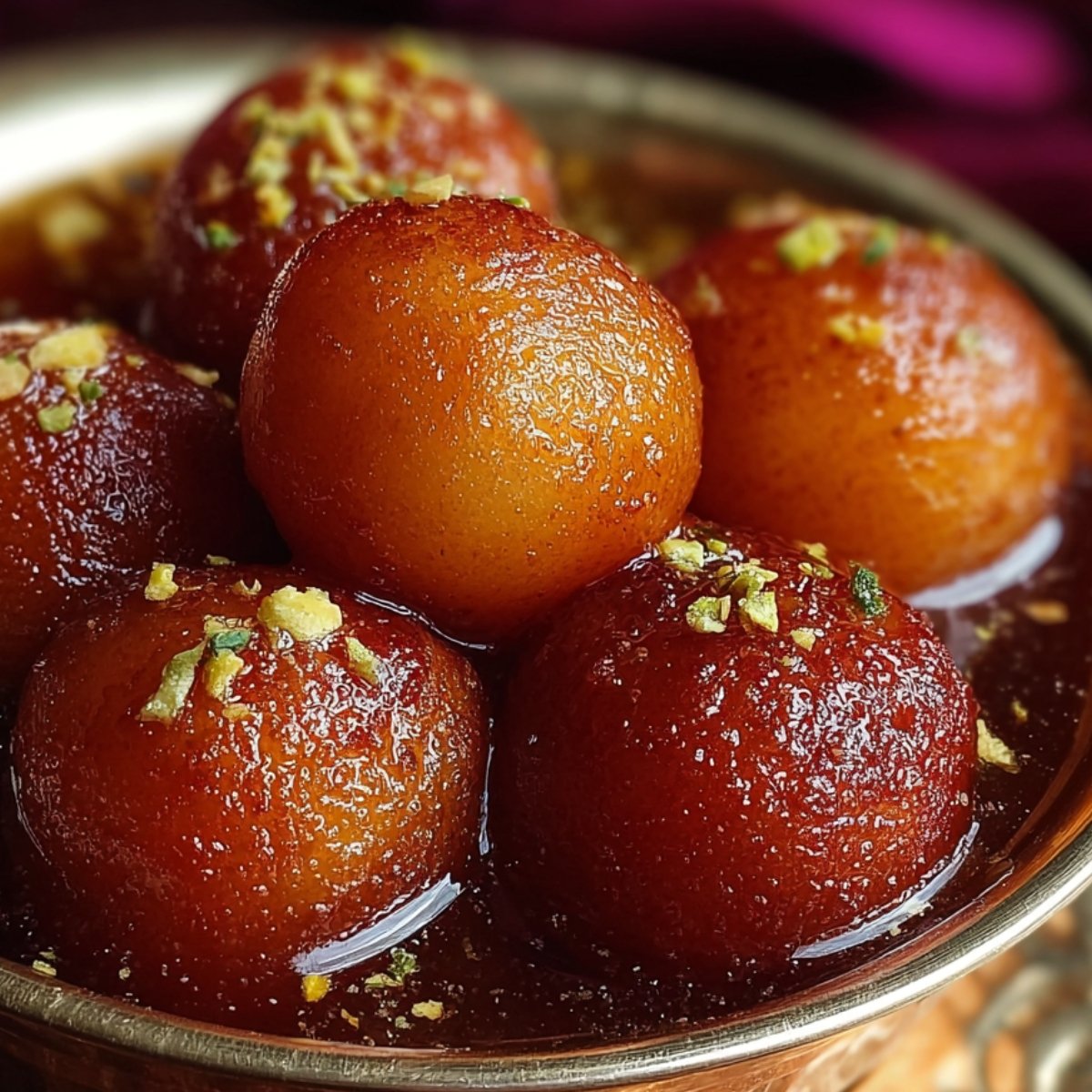
Why You'll Love This Gulab Jamun Recipe
This homemade gulab jamun brings the taste of Indian sweet shops right to your kitchen without needing special equipment or ingredients that are hard to find. After learning from my neighbor who grew up making these for family celebrations, I've figured out that success comes down to getting the dough texture right and keeping the oil at the right temperature. These soft, spongy dumplings soak up the rose-scented syrup while staying tender inside.
What makes this recipe work so well is how it uses milk powder instead of traditional khoya, which makes it much easier for home cooks to get good results every time. You can make the syrup ahead of time and fry the dumplings when you're ready to serve. The sweet, cardamom-scented syrup paired with the soft texture creates that balance that makes people pause and savor each bite. This dessert turns any regular dinner into something special and gives you that feeling of accomplishment when you master something that looks complicated but is actually doable once you know the steps.
Ingredients for Gulab Jamun
The Dumpling Base:
- Milk powder
- All-purpose flour
- Baking powder
- Ghee or melted butter
- Whole milk
- Cardamom powder
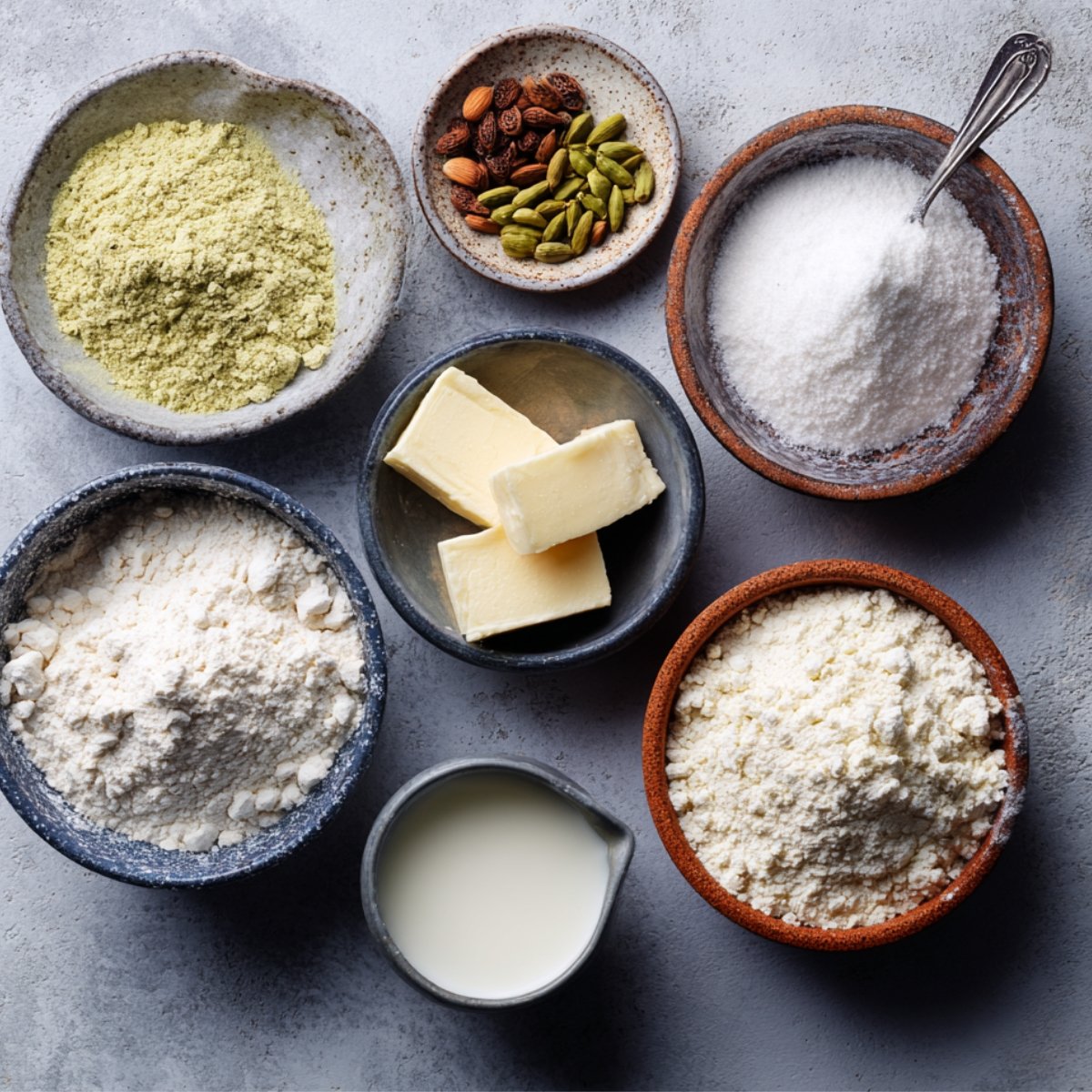
The Sugar Syrup:
- Granulated sugar
- Water
- Cardamom pods
- Rose water
- Saffron strands
- Lemon juice
For Frying:
- Vegetable oil or ghee
- Deep, heavy-bottomed pot
Basic Tools:
- Large mixing bowl
- Small saucepan for syrup
- Deep fryer or heavy pot
- Slotted spoon
- Candy thermometer
See recipe card for quantities.
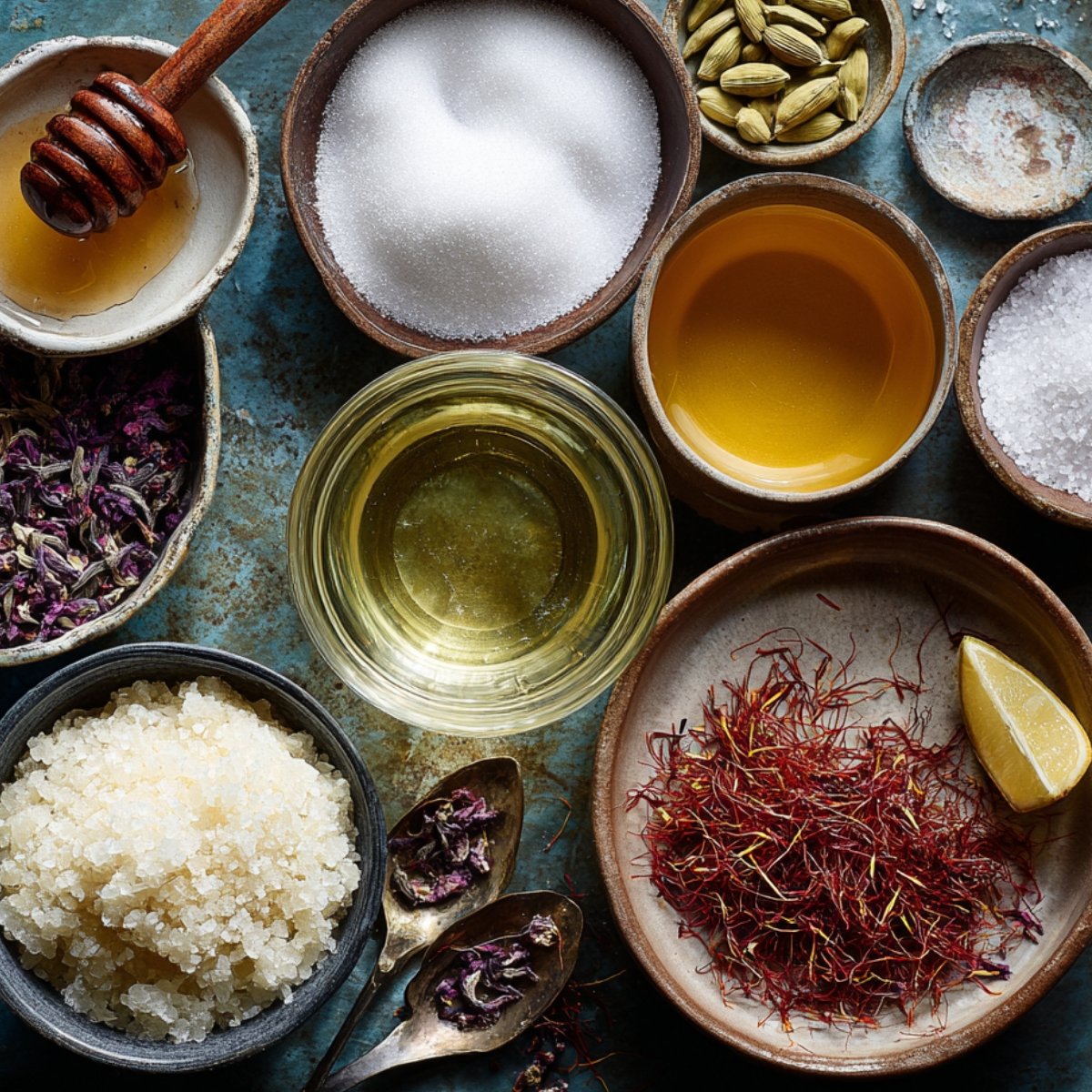
How To Make Gulab Jamun Step By Step
Make the Sugar Syrup First:
- Combine sugar and water in saucepan
- Add cardamom pods and saffron
- Boil until slightly thick
- Stir in rose water and lemon juice
- Keep warm while you fry
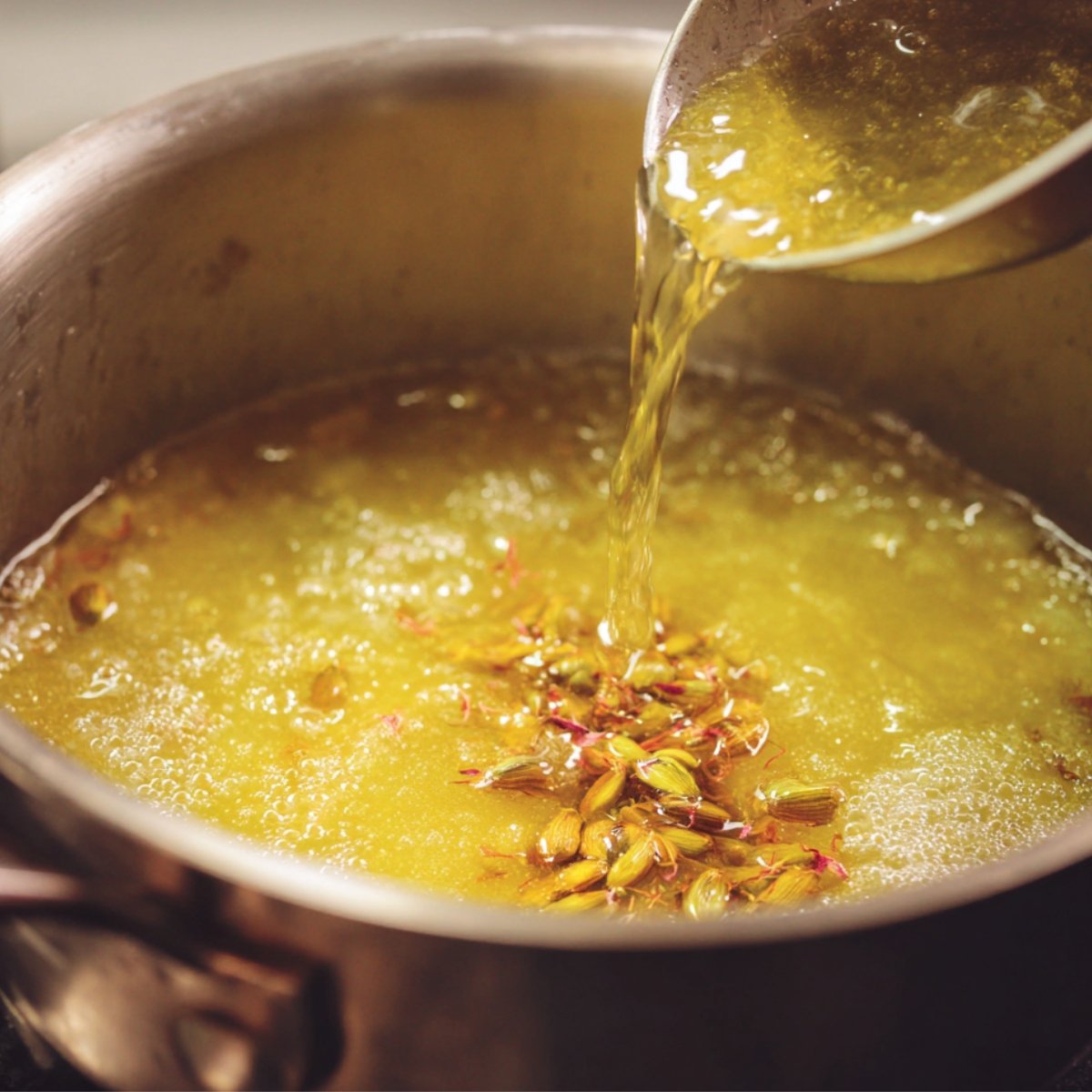
Prepare the Dough:
- Mix milk powder, flour, and baking powder
- Add ghee and mix until crumbly
- Slowly add milk until soft dough forms
- Let rest 10 minutes
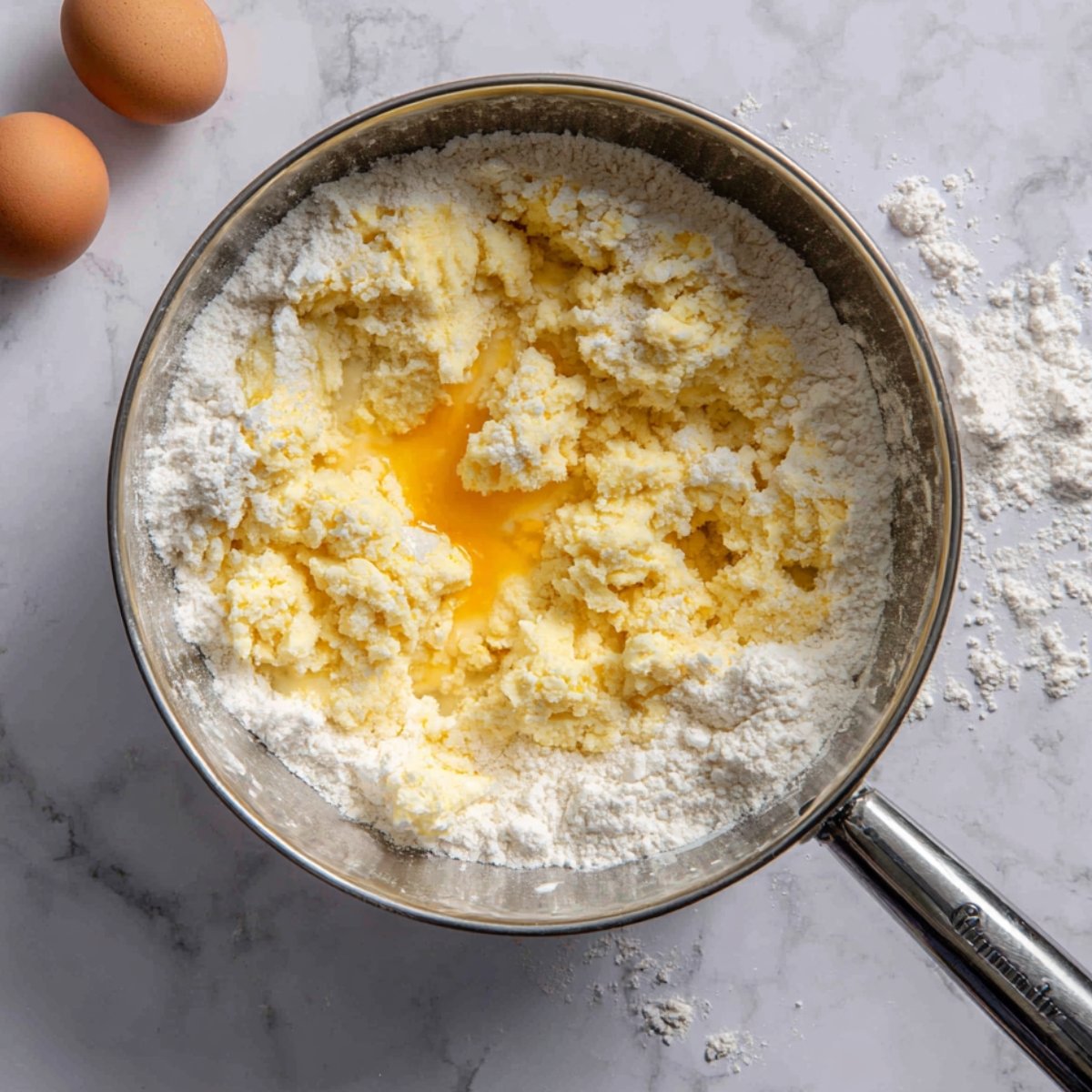
Shape the Dumplings:
- Roll small portions into smooth balls
- Make sure there are no cracks
- Keep them covered while you work
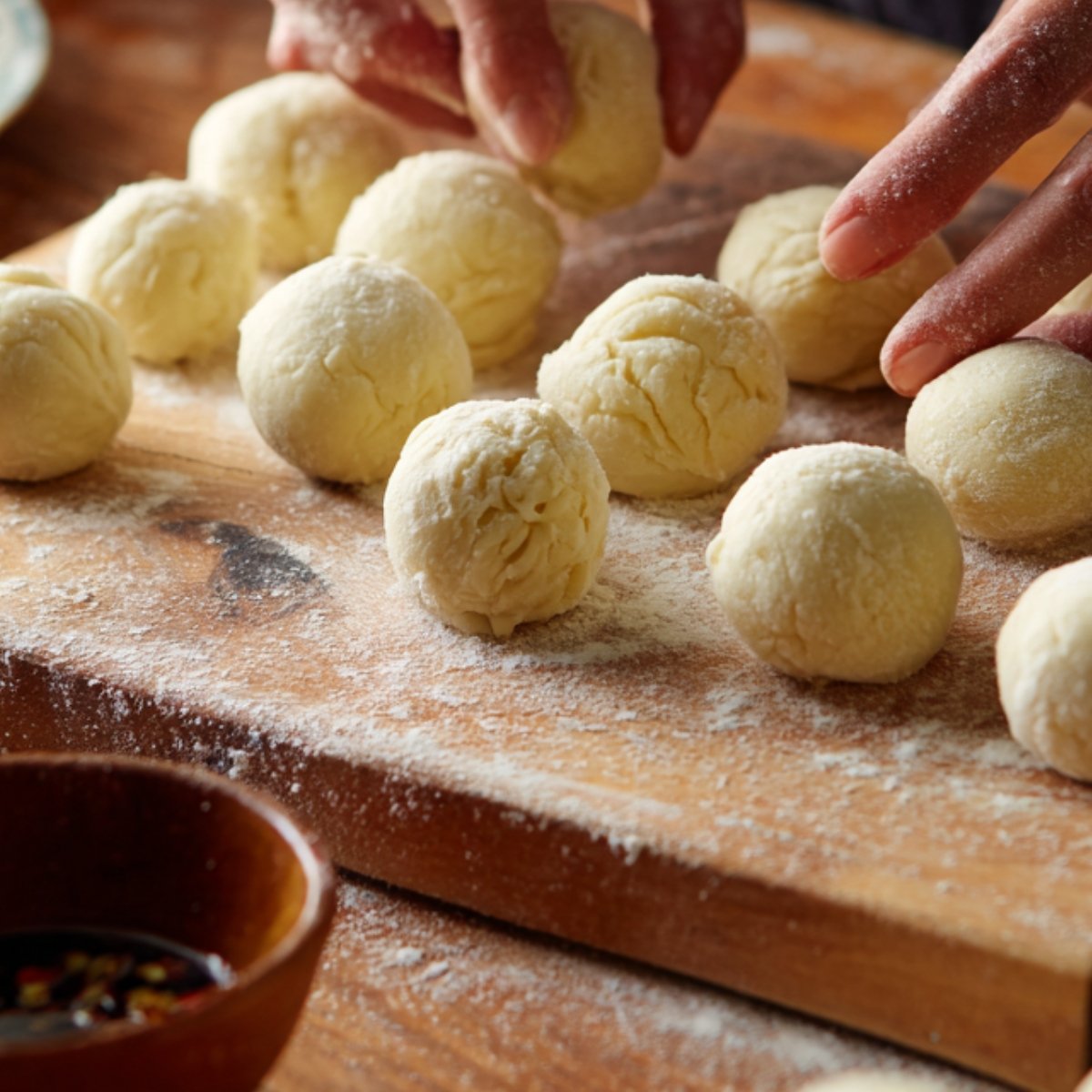
Fry to Perfection:
- Heat oil to medium temperature
- Fry a few balls at a time
- Turn gently for even browning
- Remove when golden brown all over
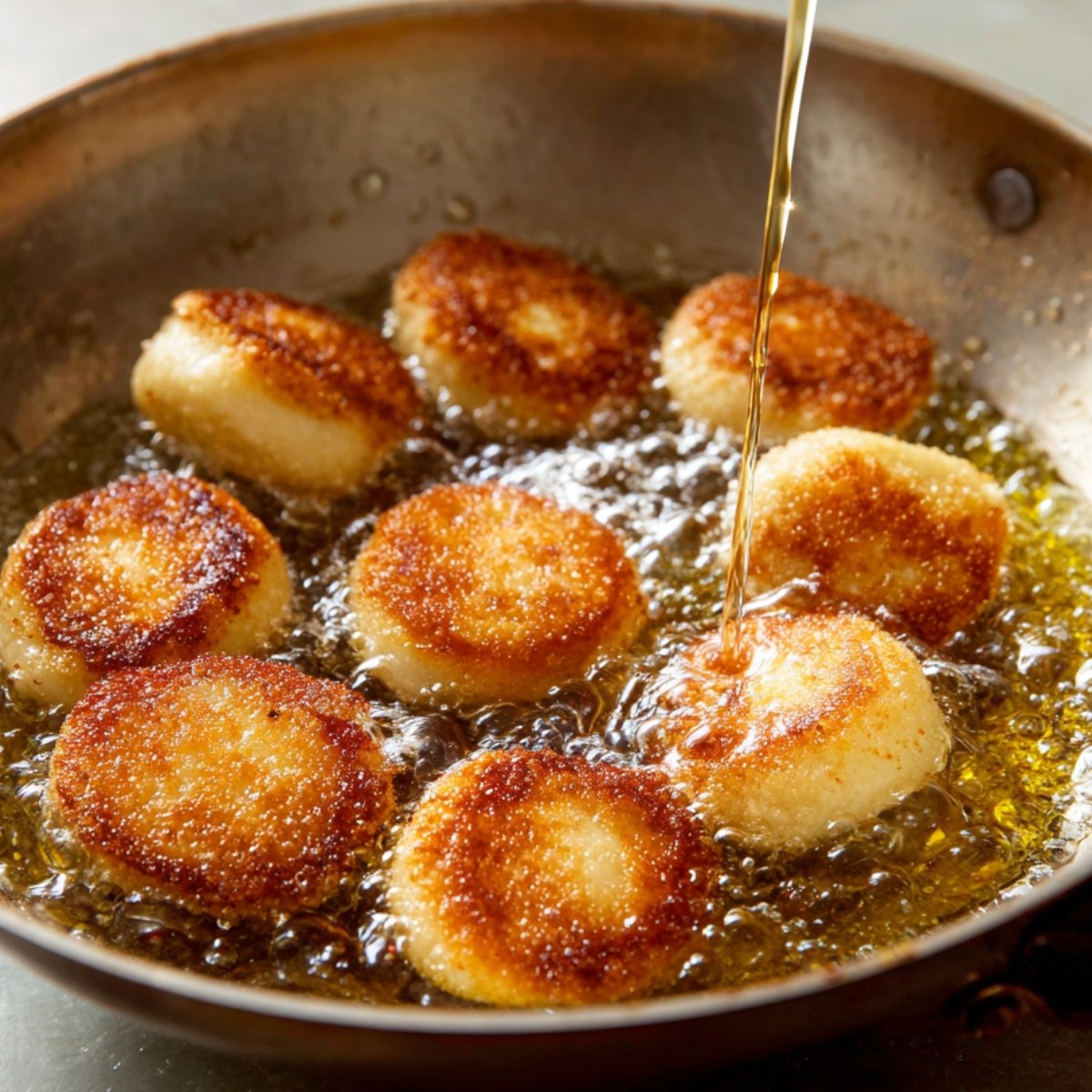
The Final Soak:
- Drop hot gulab jamun into warm syrup
- Let them soak for at least 30 minutes
- Serve warm or at room temperature
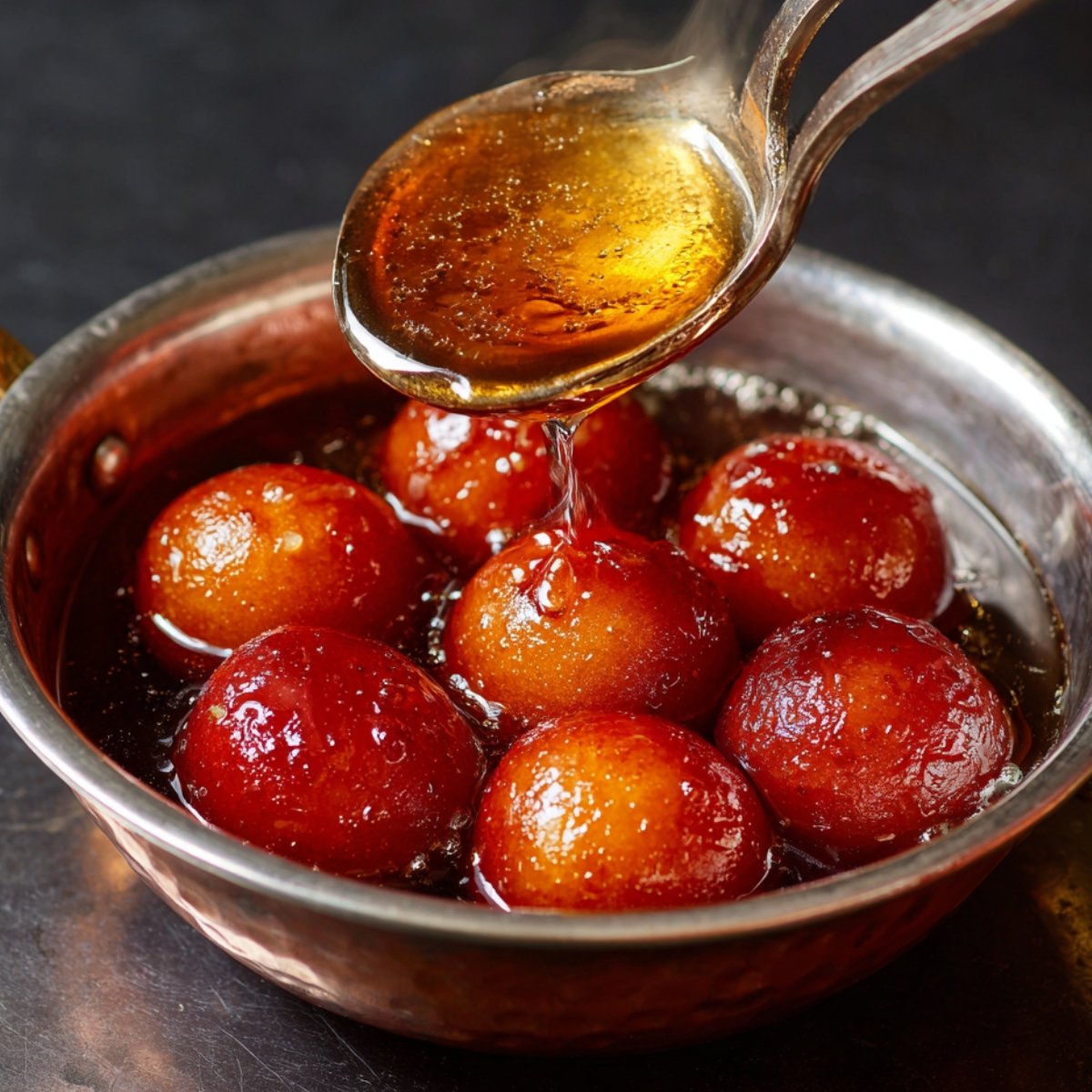
Smart Swaps for Gulab Jamun
Milk Powder Alternatives:
- Full-fat → Low-fat milk powder (add extra ghee)
- Dairy → Coconut milk powder
- Regular → Cashew powder blend
- Standard → Almond flour (texture will be different)
Flour Options:
- All-purpose → Whole wheat pastry flour
- Regular → Gluten-free flour blend
- White → Chickpea flour (besan) for traditional touch
Sweetener Changes:
- White sugar → Jaggery for deeper flavor
- Regular → Coconut sugar
- Standard → Honey (add at end of syrup making)
Liquid Swaps:
- Whole milk → Plant-based milk
- Regular → Condensed milk (reduce sugar in syrup)
- Dairy → Coconut cream
Flavor Twists:
- Rose water → Orange blossom water
- Cardamom → Cinnamon and nutmeg
- Saffron → Vanilla extract
Creative Twists on Gulab Jamun
Stuffed Versions:
- Chopped pistachios in the center
- Small piece of chocolate
- Coconut and cardamom filling
- Crushed almonds and dates
Flavor Variations:
- Chocolate gulab jamun (add cocoa powder)
- Orange zest in the dough
- Coconut flakes mixed in
- Crushed cardamom seeds
Syrup Changes:
- Mango flavored syrup
- Honey and orange blossom
- Coconut milk syrup
- Spiced chai syrup
Modern Takes:
- Mini bite-sized versions
- Baked instead of fried
- Ice cream topping
- Layered in trifle glasses
Festival Specials:
- Gold leaf garnish for weddings
- Colored with natural food coloring
- Shaped into different forms
- Extra saffron for special occasions
Equipment For Gulab Jamun
- Heavy-bottomed pot for frying
- Large mixing bowl
- Small saucepan for syrup
- Slotted spoon
- Kitchen thermometer (helpful)
Storing Your Gulab Jamun
Room Temperature (2-3 days):
- Keep in the syrup they soaked in
- Cover the bowl with plastic wrap
- Don't refrigerate unless very hot weather
- Syrup helps preserve them
Refrigerator Storage (1 week):
- Store in airtight container with syrup
- Bring to room temperature before serving
- Warm gently if you prefer them warm
- Syrup may thicken when cold
Make-Ahead Tips:
- Syrup can be made 2 days ahead
- Fried gulab jamun freeze well before soaking
- Thaw and warm syrup before adding frozen ones
- Best served within 24 hours of soaking
Not Recommended:
- Storing without syrup (they'll dry out)
- Freezing after they've soaked in syrup
- Reheating in microwave (makes them tough)
Why This Recipe Works
This gulab jamun recipe succeeds because it uses milk powder instead of traditional khoya, which eliminates the time-consuming process of reducing milk for hours while still delivering that rich, concentrated milk flavor. The ratio of milk powder to flour creates dough that's sturdy enough to hold together during frying but tender enough to absorb syrup without falling apart. Adding a small amount of baking powder gives the dumplings that characteristic light, spongy texture.
The technique works because it addresses the main challenges home cooks face with gulab jamun. The resting period allows the flour to fully hydrate, preventing cracks during rolling. Maintaining medium oil temperature ensures even cooking - the outside sets before the inside overcooks, creating that perfect contrast between the slightly firmer exterior and the soft, syrup-soaked interior.
Top Tip
- Max discovered our favorite gulab jamun trick during Diwali last year when I was making a big batch for our neighbors. While I was busy frying the dumplings, he wandered over to the spice cabinet and came back with a small jar of crushed pistachios. Before I could stop him, he'd rolled a few of the dough balls with the nuts pressed right into the surface.
- At first I thought they might fall apart during frying, but Max insisted we try them anyway. Those pistachio-crusted gulab jamun turned out to be everyone's favorite from the whole batch. The nuts toasted beautifully in the oil and added this wonderful crunch that paired perfectly with the soft, syrup-soaked interior.
- Now whenever we make gulab jamun, Max always asks to make his "special crunchy ones." He's gotten really good at pressing the nuts gently into the dough so they stay put during frying. His friends always ask for the pistachio ones when they come over, and he's proud to explain that it was his idea. Sometimes the best cooking discoveries come from kids who see possibilities that adults miss.
My Aunt's Secret Recipe That Changed Everything
My aunt taught me the most important gulab jamun lesson during a family wedding when I was struggling to get the texture right. While I was frantically adjusting ratios and temperatures, she calmly walked over and showed me her secret ingredient - a tablespoon of semolina mixed into the milk powder. "This is what keeps them from falling apart," she explained, working the coarse grains into the mixture with her fingers.
But her real breakthrough came from years of making these for temple festivals. She discovered that adding the milk one teaspoon at a time, rather than all at once, gave her complete control over the dough consistency. "Feel with your hands, not your eyes," she'd say, showing me how the dough should feel slightly sticky but not wet, firm but not dry.
FAQ
What is Gulab Jamun made of?
Gulab jamun is made from milk solids (khoya or milk powder), flour, and a small amount of baking powder, formed into balls and deep-fried until golden. The fried dumplings are then soaked in sugar syrup flavored with cardamom, rose water, and sometimes saffron for that signature sweet taste.
What does Gulab Jamun taste like?
Gulab jamun has a rich, sweet flavor with hints of cardamom and rose. The texture is soft and spongy, similar to a very tender donut that's been soaked in flavored syrup. The outside is slightly firmer while the inside melts in your mouth with concentrated sweetness.
Can Muslims eat Gulab Jamun?
Yes, gulab jamun is generally halal as it contains no prohibited ingredients - just milk products, flour, sugar, and spices. However, always check if any commercial versions use alcohol-based flavorings or non-halal additives. Homemade versions using this recipe are perfectly suitable for Muslim dietary requirements.
Is Gulab Jamun healthy or unhealthy?
Gulab jamun is a high-calorie dessert with significant sugar and fat content, so it should be enjoyed in moderation as an occasional treat. While it does provide some protein from the milk solids, it's primarily a celebratory sweet rather than an everyday food. One or two pieces during festivals or special occasions fits well into a balanced diet.
Time for Sweet Celebration!
Now you have all the secrets to making perfect gulab jamun from getting the dough texture right to Max's pistachio discovery. This beloved Indian sweet proves that the most treasured desserts often come from simple ingredients treated with care and patience.
Craving more international sweets? Try our The Best Lava Cake Recipe that layers flaky phyllo with honey and nuts. For something chocolatey, our Delicious Peach Bruschetta Recipe brings together two classic treats. Want to stay with Indian flavors? Our Easy Fresh Kimchi Recipe delivers that same aromatic sweetness in a completely different form!
Share your gulab jamun success! We love seeing your homemade celebrations!
Rate this recipe and join our dessert community!
Related
Looking for other recipes like this? Try these:
Pairing
These are my favorite dishes to serve with

Gulab Jamun
Ingredients
Equipment
Method
- Boil sugar with water, cardamom, and saffron slowly.
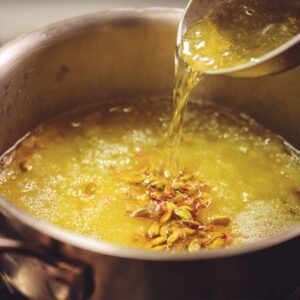
- Mix dry ingredients, add ghee and milk to form dough.
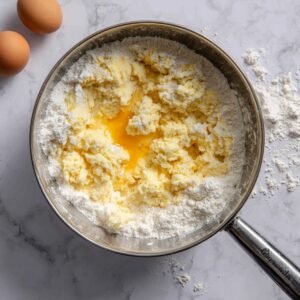
- Roll dough into smooth balls without any cracks.
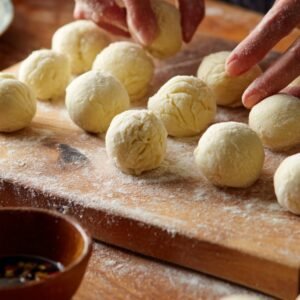
- Fry balls gently on medium-low heat until golden.
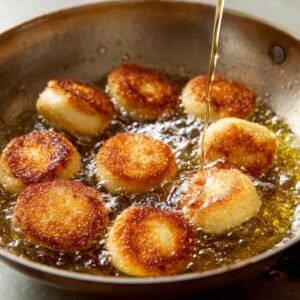
- Soak fried balls in warm syrup for at least 30 minutes.
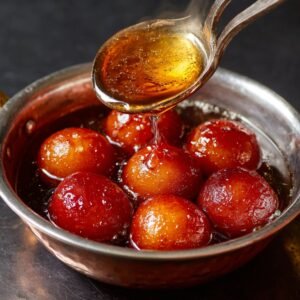

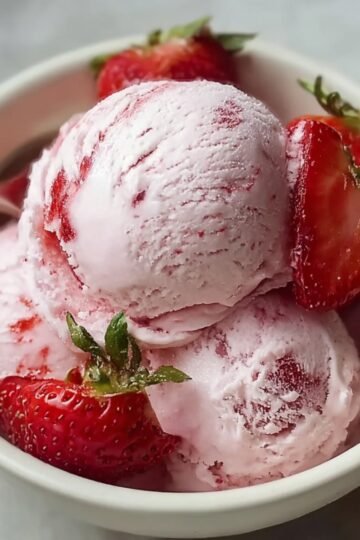
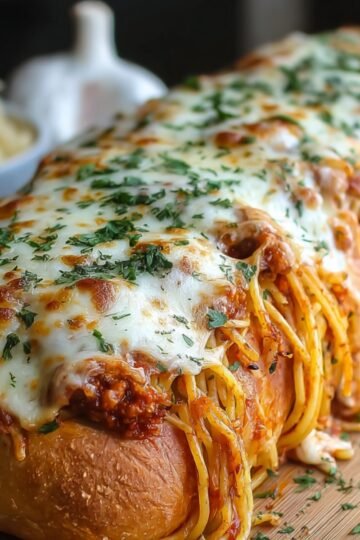
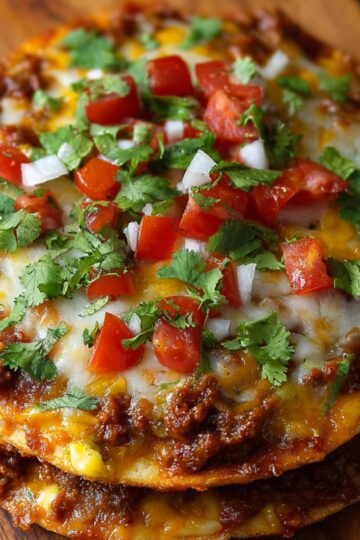
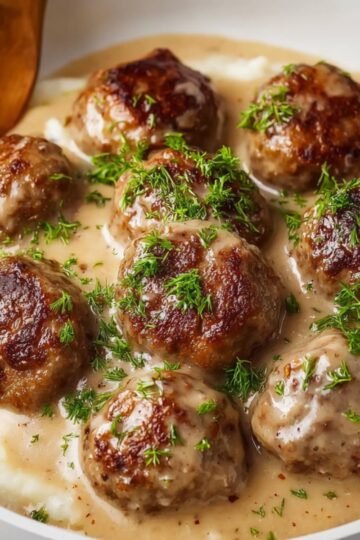
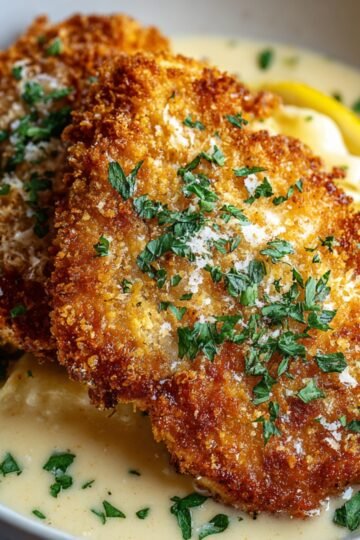
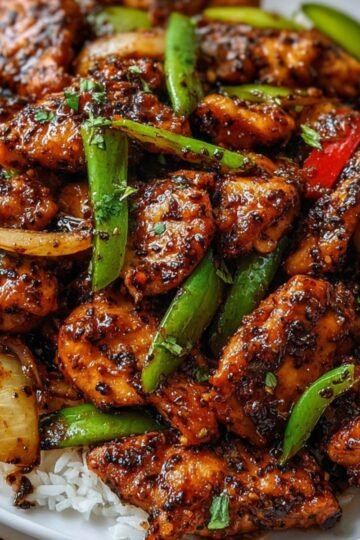
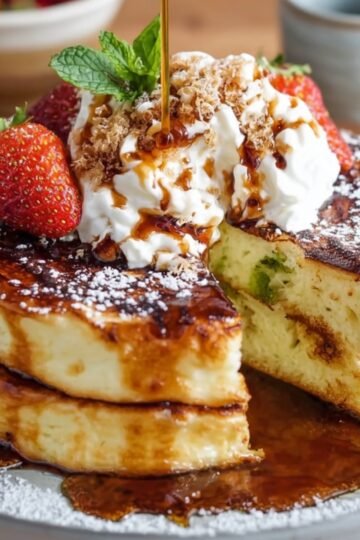
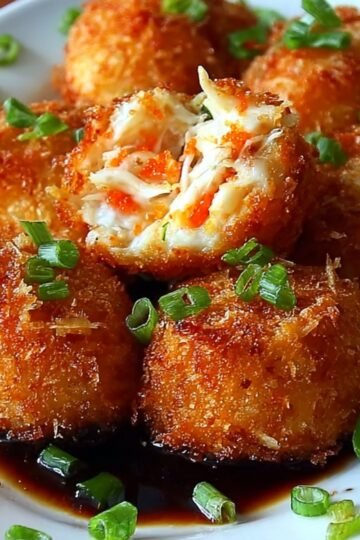
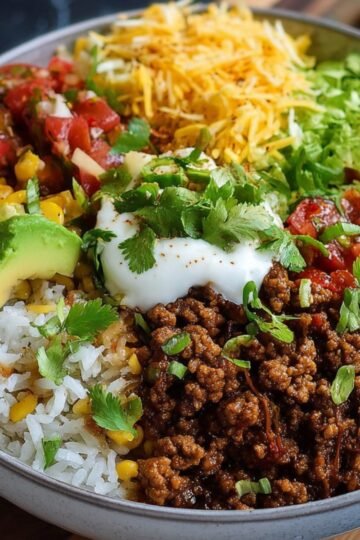
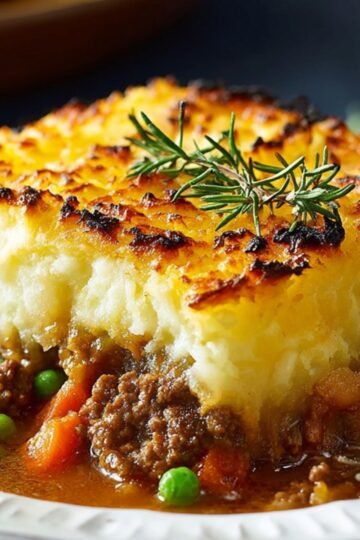
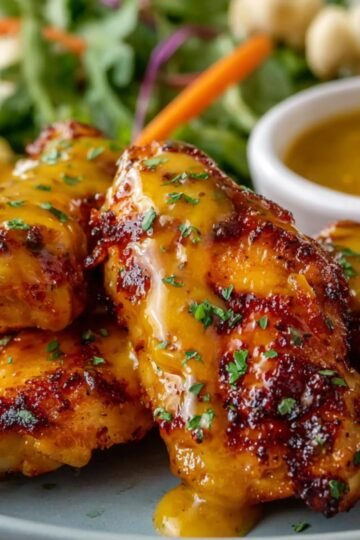
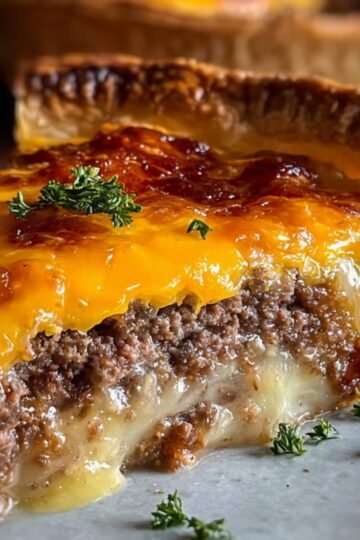
Leave a Reply